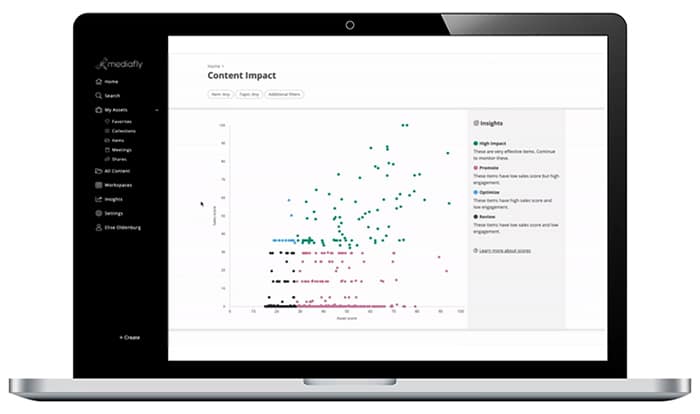
If you are like most marketing leaders, you know the value of good content, and as a result, invest heavily to write and create insightful and compelling content for your sellers.
How much is spent each year? According to the Content Marketing Institute, a significant 28% of marketing spend is currently invested for content.
With so much annual content spend, executives are rightly questioning the wisdom of these investments. Is the content being used by sellers, consumed by buyers, and most importantly, is the content having an impact on deal flow?
The good news, Gartner research found that customers receiving informative and valuable content from suppliers were 2.8x more likely to experience a “high degree of purchase ease”, and 3x more likely to “buy a bigger deal with less regret”. The right content really does work!
However, it’s not all good news. Forrester indicates that that a whopping 65% of all content falls into the not relevant, unused or underutilized bucket, and that this amounts to the average organization wasting $2.3 million annually.
So how do you know what content is worth it?
At our EVOLVE 2020 conference I had the opportunity to interview CMO Isabelle Papoulias, VP of Sales Dustin Zweck and Sales Enablement Director Elise Oldenburg, to get a 360 degree perspective on sales content investment tracking, intelligence and optimization.
First and foremost, the team highlighted the increased accountability that has occurred post-crisis. Isabelle said it best, in that there is an “Increasing pressure to be hyper-focused on what works and to stop doing things that doesn’t work. But to do this, you first need clarity on what actually works and what doesn’t, and this is sometimes hard to glean if you are not measuring and tracking what matters most.”
And the best are ahead of the curve with regard to transparency, with 89% of top-performers indicating to the Content Marketing Institute (CMI) that technology is being leveraged to glean better insight into how content is performing.
In my interview with Isabelle and the team, they shared exactly what they use for accountability and optimization: a Content Impact dashboard that tracks content usage, sharing and consumption aligned with the impact that the content being leveraged has on sales success. By visually plotting the information, insights are clearly delivered.
“This is my go to report as a CMO, delivering the single most important visibility into what sales content is working or not, and how to assess campaign success and drive investment decisions going forward”, according to Isabelle.
Each content asset is tracked and plotted visually on the X-axis with regards to an Asset Score and in the Y axis according to a Sales Score.
Those assets that are “up and to the right” are both highly used by sellers, shared and consumed with customers AND also contributed to accelerating deals to the next stage and eventually to close, and impacting sales performance metrics of win rate, deal-size and sales success. Isabelle calls this “Champion Content”.
Those in the lower right are highly used, but aren’t correlating with deal impact, and as such should be investigated further. Sending buyers irrelevant or non-impactful content nowadays results in over-choice shown to slow down or even stall decision making.
While for the sales content in the upper left, impacts to deal performance are high but usage by sellers and sharing with customers is low – a great opportunity to perhaps illuminate and promote to sellers for more usage in support of more effective customer engagements.
Of great importance to marketers is the content in the lower left – where usage / consumption is low AND when used, non-correlated to performance. It is this content that might be leading to sales information overload and unworthy go forward investments. Isabelle refers to this bucket as “Review Content”.
When research firm SiriusDecisions (now Forrester) asked high performing organizations what they track and report from their Sales Asset Management (SAM) system, the responses indicates a shift to content sharing and performance, versus just whether the content is being used on not by sellers.
- 69% – Content sent to buyers
- 59% – Number of content views
- 59% – Content tied to deal progression
- 59% – Won deals by content usage
- 59% – Content usage by rep. (SiriusDecisions – Sales Asset Management Research Survey 2019)
This is shown in CMI research as well, with 72% of top-performing organizations now going a step beyond just tracking seller usage and sharing, seeking further understanding and measuring the ROI of their content.
According to CMO Isabelle, “The Content Impact insights provides a great dashboard to visually correlate asset and content scores and provide “the holy grail” of sales content optimization: helping to guide refinement of the sales content library, identify better ways to promote the right content to sellers, and guide future content and campaign investments”.
Checkout the On-Demand session Make Your Content Work HarderL Leverage Sales Content Intelligence to Drive Predictable Sales – https://viewer.www.mediafly.com/mediafly_share#/video/75230721d2a1466c85ee39361908c4feproduct888694?parentSlug=75230721d2a1466c85ee39361908c4feproduct888091
#b2b #sales #marketing #salesenablement #digitalselling #remoteselling #virtualselling #salesenablement #intelligence #content #contentimpact #insights #usage #consumption #salestech #salestechnology #contentmanagement #ROI #salesintelligence #salesoptimization #salestransformation #AI #ML #automation #salesanalytics #salesperformance

Comments are closed.